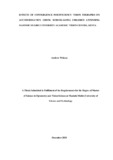EFFECTS OF CONVERGENCE INSUFFICIENCY VISION THERAPIES ON ACCOMMODATION AMONG SCHOOL-GOING CHILDRENATTENDING MASINDE MULIRO UNIVERSITY ACADEMIC VISION CENTRE, KENYA
Abstract
Convergence Insufficiency (CI) is the most common binocular vision anomaly among school-going childrensince they engage inprolonged near work. On the other hand, accommodationis the crystalline lens of the eye to adjust its dioptric power when viewing near work. Convergence and accommodation are always yoked together. Hence any adjustment that is done on the former still affects the latter. The most effective treatment for CI isvision therapy.The study aimed to determine the effects of vision therapies on accommodation among school-going children attendingwith CI attending the Masinde Muliro University Academic Vision Center in Kenya. The study useda comparativeexperimentalstudydesign where46 participantswithamean ageof14±2yearswere recruited to participate. There were16(35.4%)males and30(64.6%) females distributed into two groups of home-basedvision therapy carried at homeand office-based vision therapy performed in the officefor nine weeks.Shapiro Wilks test was performed to ascertain whether or not the data was normally distributed. The Paired t-test and Wilcoxon test were used tocompare mean values within the groups, and the independent t-test was used to compare mean values between groups. The mean value of negative relativeaccommodation (NRA) before and after home-based therapy was statistically significant (p= 0.01).However,the mean values before and afterhome-based therapy for the near point of accommodation(NPA), dynamic (Lag), relativity (PRA),and facility(MAF)showed no difference(p> 0.05). The mean value of the NRA before and after office-based vision therapy was statistically significant (p=0.01). However,the mean values before and after office-based therapy for the near point of accommodation (NPA), dynamic (Lag), relativity (PRA),and facility(MAF) were statistically insignificant (p> 0.05).The comparison between office-based vision therapy and home-based vision therapy showed no significant difference in accommodation.The study also noted that office-based and home-based vision therapy had the same effect on accommodation.Theseresultsimply that when the patient has CI and accommodation problems, the treatment should combine both vergence and accommodation therapy to bring the desired therapy except on NRA, which will respond to CI vision therapy alone.

